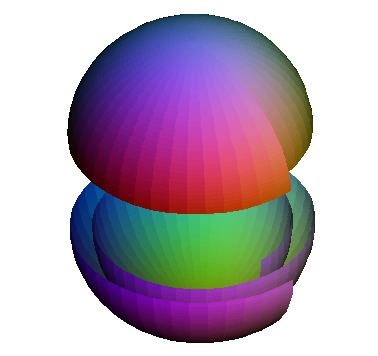 | ||
In topology, the degree of a continuous mapping between two compact oriented manifolds of the same dimension is a number that represents the number of times that the domain manifold wraps around the range manifold under the mapping. The degree is always an integer, but may be positive or negative depending on the orientations.
Contents
The degree of a map was first defined by Brouwer, who showed that the degree is homotopy invariant (invariant among homotopies), and used it to prove the Brouwer fixed point theorem. In modern mathematics, the degree of a map plays an important role in topology and geometry. In physics, the degree of a continuous map (for instance a map from space to some order parameter set) is one example of a topological quantum number.
From Sn to Sn
The simplest and most important case is the degree of a continuous map from the
Let
Algebraic topology
Let X and Y be closed connected oriented m-dimensional manifolds. Orientability of a manifold implies that its top homology group is isomorphic to Z. Choosing an orientation means choosing a generator of the top homology group.
A continuous map f : X→Y induces a homomorphism f* from Hm(X) to Hm(Y). Let [X], resp. [Y] be the chosen generator of Hm(X), resp. Hm(Y) (or the fundamental class of X, Y). Then the degree of f is defined to be f*([X]). In other words,
If y in Y and f −1(y) is a finite set, the degree of f can be computed by considering the m-th local homology groups of X at each point in f −1(y).
Differential topology
In the language of differential topology, the degree of a smooth map can be defined as follows: If f is a smooth map whose domain is a compact manifold and p is a regular value of f, consider the finite set
By p being a regular value, in a neighborhood of each xi the map f is a local diffeomorphism (it is a covering map). Diffeomorphisms can be either orientation preserving or orientation reversing. Let r be the number of points xi at which f is orientation preserving and s be the number at which f is orientation reversing. When the domain of f is connected, the number r − s is independent of the choice of p (though n is not!) and one defines the degree of f to be r − s. This definition coincides with the algebraic topological definition above.
The same definition works for compact manifolds with boundary but then f should send the boundary of X to the boundary of Y.
One can also define degree modulo 2 (deg2(f)) the same way as before but taking the fundamental class in Z2 homology. In this case deg2(f) is an element of Z2 (the field with two elements), the manifolds need not be orientable and if n is the number of preimages of p as before then deg2(f) is n modulo 2.
Integration of differential forms gives a pairing between (C∞-)singular homology and de Rham cohomology: <[c], [ω]> = ∫cω, where [c] is a homology class represented by a cycle c and ω a closed form representing a de Rham cohomology class. For a smooth map f : X→Y between orientable m-manifolds, one has
where f* and f* are induced maps on chains and forms respectively. Since f*[X] = deg f · [Y], we have
for any m-form ω on Y.
Maps from closed region
If
where
The degree satisfies the following properties:
These properties characterise the degree uniquely and the degree may be defined by them in an axiomatic way.
In a similar way, we could define the degree of a map between compact oriented manifolds with boundary.
Properties
The degree of a map is a homotopy invariant; moreover for continuous maps from the sphere to itself it is a complete homotopy invariant, i.e. two maps
In other words, degree is an isomorphism between
Moreover, the Hopf theorem states that for any
A self-map
